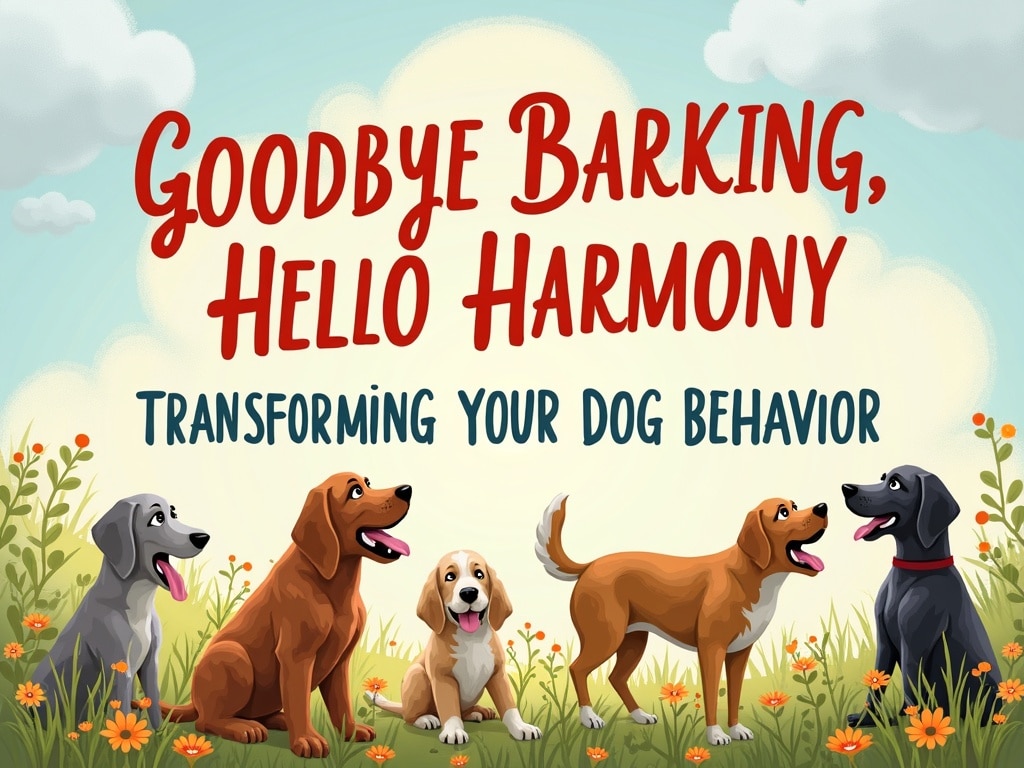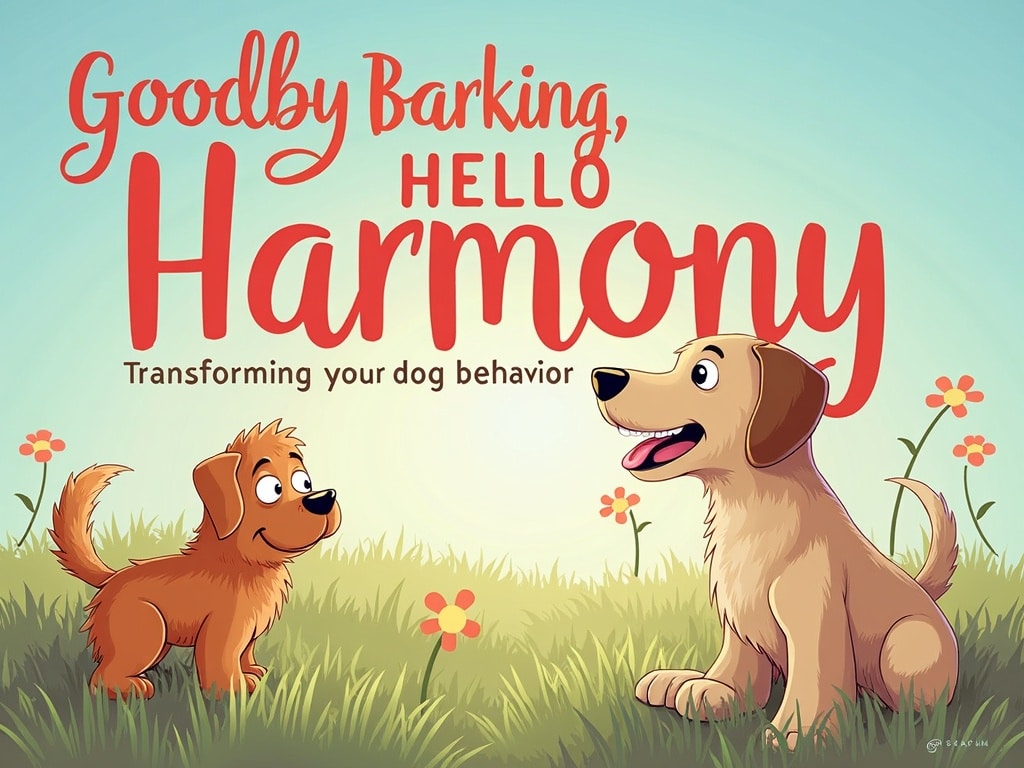Goodbye Barking, Hello Harmony: Transforming Your Dog’s Behavior
Imagine a home filled with peace, where the only sounds are gentle snores and the clinking of a water bowl. Now, picture your reality: a constant barrage of barking, triggered by everything from the mailman’s arrival to a rogue leaf blowing across the lawn. If the latter sounds more familiar, you’re not alone. Many dog owners struggle with excessive barking. But fear not! Transforming your dog’s behavior is possible. It requires understanding, patience, and the right techniques. Let’s dive into how you can achieve a quieter, more harmonious home.
Understanding Why Your Dog Barks: Decoding the Different Types of Barks
Before you can address the barking, you need to understand the why. Dogs bark for various reasons, and identifying the type of bark is crucial. Is it a territorial bark, warning off intruders? Or a boredom bark, signaling a need for attention? Perhaps it’s an alert bark, triggered by a specific sound or sight.
- Territorial Barking: Often deep and repetitive, directed at perceived threats to their territory.
- Alarm Barking: Sharper and more urgent, signaling something out of the ordinary.
- Attention-Seeking Barking: Can be whiny or demanding, often accompanied by pawing or other attention-seeking behaviors.
- Boredom Barking: Often monotonous and repetitive, indicating a lack of mental or physical stimulation.
- Separation Anxiety Barking: Accompanied by other signs of distress, such as pacing, whining, or destructive behavior.
- Greeting Barking: Excited and high-pitched, usually directed at people or other animals they know.
Paying close attention to the context surrounding the barking will help you determine the root cause. Keep a journal, noting when, where, and why your dog is barking to identify patterns.

Identifying Triggers: What’s Making Your Dog Bark at Everything?
Once you understand the types of barks, pinpoint the triggers. What specific stimuli set your dog off? Common triggers include:
- People: Strangers, neighbors, delivery personnel.
- Animals: Squirrels, cats, other dogs.
- Sounds: Doorbell, sirens, car alarms.
- Movement: Cars passing by, people walking, shadows.
Consider the environment. Does your dog have a clear view of the street? Are there noises that are particularly bothersome? The more specific you can be about the triggers, the better you can tailor your management and training strategies.
Training Techniques to Reduce Excessive Barking: Positive Reinforcement Methods
Positive reinforcement is key to effective training. Reward your dog for desired behavior — in this case, quietness. Never punish barking, as this can create anxiety and make the problem worse. Here are some effective techniques:
- Reward Quiet Behavior: When your dog is quiet, even for a few seconds, offer praise and a treat. Gradually increase the duration of quietness required for the reward.
- Desensitization and Counter-Conditioning: Expose your dog to the trigger at a low intensity (e.g., playing a recording of a doorbell at a low volume) and reward them for remaining calm. Gradually increase the intensity as they become more comfortable.
- Distraction Techniques: When you anticipate a trigger, redirect your dog’s attention with a toy, puzzle, or command they enjoy.
Consistency is crucial. Everyone in the household should use the same commands and reinforcement strategies.
Management Strategies: Modifying the Environment to Minimize Barking Opportunities
Sometimes, managing the environment is the most effective way to reduce barking. This involves making changes to minimize your dog’s exposure to triggers.
- Block Visual Access: Use curtains, blinds, or window film to prevent your dog from seeing outside.
- Soundproofing: Install thicker windows or doors to reduce outside noise.
- Create a Safe Space: Provide a comfortable, quiet den-like area where your dog can retreat when feeling anxious or overwhelmed.
- Move Your Dog Away From Windows: Keep your dog in a crate away from windows.
By limiting exposure to triggers, you can significantly reduce the frequency of barking.
When to Seek Professional Help: Consulting a Veterinarian or Certified Dog Trainer
If you’ve tried various training and management techniques without success, it may be time to seek professional help. A veterinarian can rule out any underlying medical conditions that may be contributing to the barking. A certified dog trainer or behaviorist can provide personalized guidance and develop a tailored training plan.
For the cases of leash reactivity, refer to this to learn how to keep your dog calm on walks: Leash Reactivity SOS: Is Your Dog a Barking Bandit on Walks?
The Role of Exercise and Mental Stimulation: Keeping Your Dog Engaged and Tired

A tired dog is a good dog. Regular exercise and mental stimulation can significantly reduce boredom barking. Ensure your dog gets plenty of physical activity, such as walks, runs, or playtime. Provide them with mental challenges, such as puzzle toys, training sessions, or interactive games.
- Daily Walks: Provide physical exercise and exposure to new sights and smells.
- Puzzle Toys: Keep your dog mentally stimulated and occupied.
- Training Sessions: Reinforce obedience commands and teach new tricks.
- Interactive Games: Play fetch, tug-of-war, or hide-and-seek.
A well-exercised and mentally stimulated dog is less likely to bark out of boredom or frustration.
Addressing Separation Anxiety: Is That The Cause of The Barking?
If your dog only barks when you’re away, separation anxiety may be the culprit. Other signs of separation anxiety include destructive behavior, pacing, and elimination in the house.
Here are some strategies to address separation anxiety:
- Counter-Conditioning: Associate your departure with positive experiences, such as giving your dog a special treat or toy they only get when you leave.
- Desensitization: Gradually accustom your dog to your departures by starting with short absences and gradually increasing the duration.
- Create a Safe and Comfortable Space: Provide a den-like area with familiar items and comforting scents.
- Medication: In severe cases, your veterinarian may recommend medication to help manage your dog’s anxiety.
The Quiet Command: How to Teach Your Dog to Stop Barking on Cue
Teaching your dog a quiet command can be a valuable tool in managing barking. Here’s how to do it:
- Encourage Barking: Intentionally trigger your dog to bark (e.g., by ringing the doorbell).
- Say Quiet: As your dog barks, say Quiet in a calm but firm voice.
- Interrupt and Reward: Immediately interrupt the barking (e.g., by gently placing your hand over their muzzle) and, as soon as they stop, say Good Quiet and give them a treat.
- Practice Regularly: Practice the Quiet command in various situations and with different triggers.
Be patient and consistent. It may take time for your dog to associate the command with the desired behavior.
Common Mistakes to Avoid: Pitfalls That Can Make Barking Worse
Certain behaviors can inadvertently reinforce barking. Avoid these common mistakes:
- Yelling at Your Dog: This can be perceived as barking along with them, reinforcing the behavior.
- Giving Attention When Barking: Even negative attention (e.g., scolding) can be rewarding for some dogs.
- Inconsistency: Not enforcing the Quiet command consistently can confuse your dog.
- Punishment: Punishing barking can create anxiety and aggression.
Be mindful of your actions and ensure you’re not unintentionally rewarding the behavior you’re trying to eliminate.
Long-Term Solutions for a Quieter Home: Creating a Calm and Predictable Environment
The ultimate goal is to create a calm and predictable environment that minimizes the need for barking. This involves:
- Consistent Routine: Establish a regular schedule for feeding, exercise, and rest.
- Ongoing Training: Continue to reinforce obedience commands and address any new triggers that may arise.
- Calming Atmosphere: Create a relaxing environment with soft music, comfortable bedding, and familiar scents.
- Patience and Understanding: Remember that behavior modification takes time and effort. Be patient with your dog and celebrate small successes along the way.
By implementing these strategies, you can transform your dog’s behavior and create a quieter, more harmonious home for both of you. Say goodbye to constant barking and hello to a peaceful, loving companionship.

